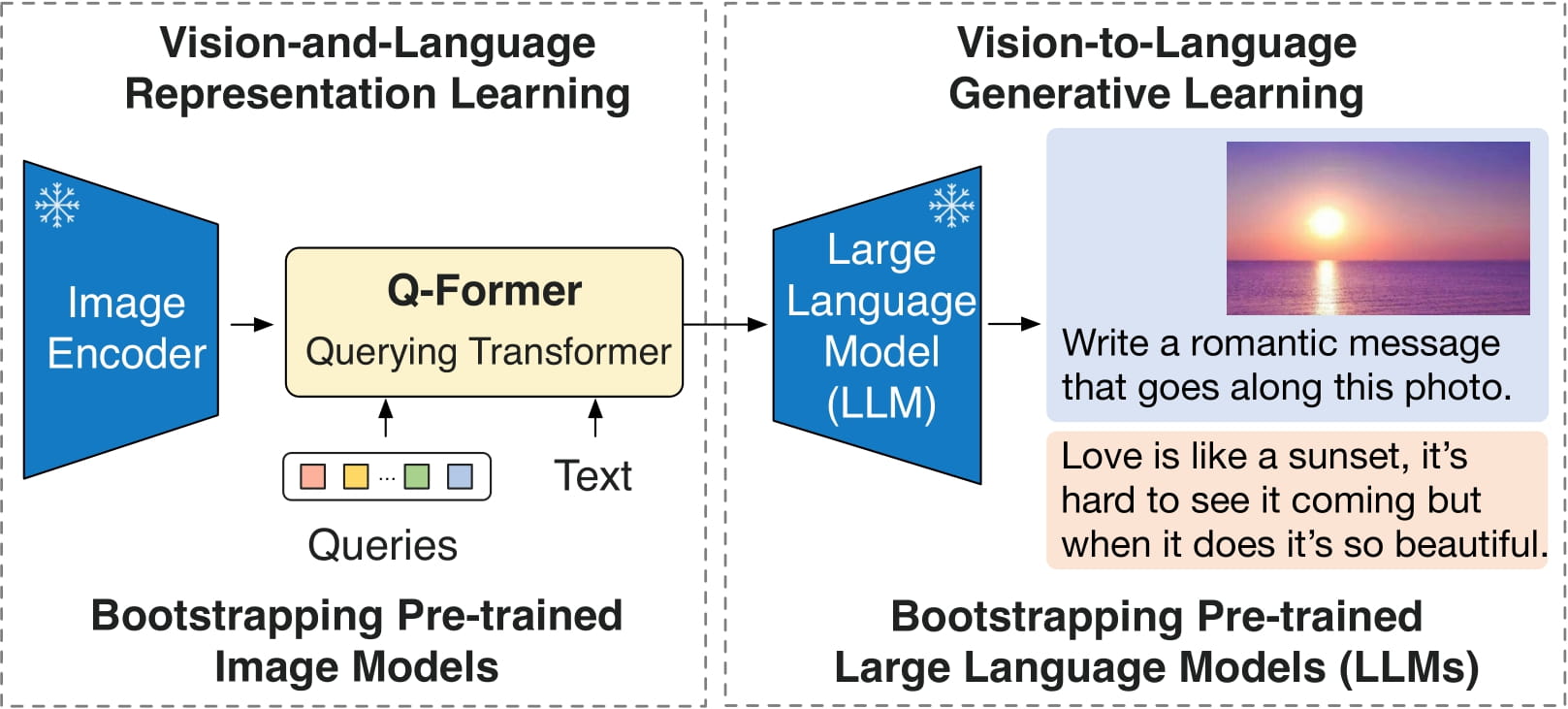BLIP-2, Flan T5-xxl, pre-trained only
BLIP-2 model, leveraging Flan T5-xxl (a large language model). It was introduced in the paper BLIP-2: Bootstrapping Language-Image Pre-training with Frozen Image Encoders and Large Language Models by Li et al. and first released in this repository.
Disclaimer: The team releasing BLIP-2 did not write a model card for this model so this model card has been written by the Hugging Face team.
Model description
BLIP-2 consists of 3 models: a CLIP-like image encoder, a Querying Transformer (Q-Former) and a large language model.
The authors initialize the weights of the image encoder and large language model from pre-trained checkpoints and keep them frozen while training the Querying Transformer, which is a BERT-like Transformer encoder that maps a set of "query tokens" to query embeddings, which bridge the gap between the embedding space of the image encoder and the large language model.
The goal for the model is simply to predict the next text token, giving the query embeddings and the previous text.

This allows the model to be used for tasks like:
- image captioning
- visual question answering (VQA)
- chat-like conversations by feeding the image and the previous conversation as prompt to the model
Direct Use and Downstream Use
You can use the raw model for conditional text generation given an image and optional text. See the model hub to look for fine-tuned versions on a task that interests you.
Bias, Risks, Limitations, and Ethical Considerations
BLIP2-FlanT5 uses off-the-shelf Flan-T5 as the language model. It inherits the same risks and limitations from Flan-T5:
Language models, including Flan-T5, can potentially be used for language generation in a harmful way, according to Rae et al. (2021). Flan-T5 should not be used directly in any application, without a prior assessment of safety and fairness concerns specific to the application.
BLIP2 is fine-tuned on image-text datasets (e.g. LAION ) collected from the internet. As a result the model itself is potentially vulnerable to generating equivalently inappropriate content or replicating inherent biases in the underlying data.
BLIP2 has not been tested in real world applications. It should not be directly deployed in any applications. Researchers should first carefully assess the safety and fairness of the model in relation to the specific context they’re being deployed within.
How to use
For code examples, we refer to the documentation, or refer to the snippets below depending on your usecase:
Running the model on CPU
Click to expand
import requests
from PIL import Image
from transformers import BlipProcessor, Blip2ForConditionalGeneration
processor = BlipProcessor.from_pretrained("Salesforce/blip2-flan-t5-xxl")
model = Blip2ForConditionalGeneration.from_pretrained("Salesforce/blip2-flan-t5-xxl")
img_url = 'https://storage.googleapis.com/sfr-vision-language-research/BLIP/demo.jpg'
raw_image = Image.open(requests.get(img_url, stream=True).raw).convert('RGB')
question = "how many dogs are in the picture?"
inputs = processor(raw_image, question, return_tensors="pt")
out = model.generate(**inputs)
print(processor.decode(out[0], skip_special_tokens=True))
Running the model on GPU
In full precision
Click to expand
# pip install accelerate
import requests
from PIL import Image
from transformers import Blip2Processor, Blip2ForConditionalGeneration
processor = Blip2Processor.from_pretrained("Salesforce/blip2-flan-t5-xxl")
model = Blip2ForConditionalGeneration.from_pretrained("Salesforce/blip2-flan-t5-xxl", device_map="auto")
img_url = 'https://storage.googleapis.com/sfr-vision-language-research/BLIP/demo.jpg'
raw_image = Image.open(requests.get(img_url, stream=True).raw).convert('RGB')
question = "how many dogs are in the picture?"
inputs = processor(raw_image, question, return_tensors="pt").to("cuda")
out = model.generate(**inputs)
print(processor.decode(out[0], skip_special_tokens=True))
In half precision (float16)
Click to expand
# pip install accelerate
import torch
import requests
from PIL import Image
from transformers import Blip2Processor, Blip2ForConditionalGeneration
processor = Blip2Processor.from_pretrained("Salesforce/blip2-flan-t5-xxl")
model = Blip2ForConditionalGeneration.from_pretrained("Salesforce/blip2-flan-t5-xxl", torch_dtype=torch.float16, device_map="auto")
img_url = 'https://storage.googleapis.com/sfr-vision-language-research/BLIP/demo.jpg'
raw_image = Image.open(requests.get(img_url, stream=True).raw).convert('RGB')
question = "how many dogs are in the picture?"
inputs = processor(raw_image, question, return_tensors="pt").to("cuda", torch.float16)
out = model.generate(**inputs)
print(processor.decode(out[0], skip_special_tokens=True))
In 8-bit precision (int8)
Click to expand
# pip install accelerate bitsandbytes
import torch
import requests
from PIL import Image
from transformers import Blip2Processor, Blip2ForConditionalGeneration
processor = Blip2Processor.from_pretrained("Salesforce/blip2-flan-t5-xxl")
model = Blip2ForConditionalGeneration.from_pretrained("Salesforce/blip2-flan-t5-xxl", load_in_8bit=True, device_map="auto")
img_url = 'https://storage.googleapis.com/sfr-vision-language-research/BLIP/demo.jpg'
raw_image = Image.open(requests.get(img_url, stream=True).raw).convert('RGB')
question = "how many dogs are in the picture?"
inputs = processor(raw_image, question, return_tensors="pt").to("cuda", torch.float16)
out = model.generate(**inputs)
print(processor.decode(out[0], skip_special_tokens=True))
- Downloads last month
- 8,112